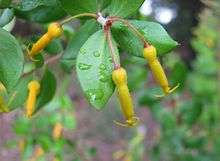Persoonia myrtilloides
| Persoonia myrtilloides | |
|---|---|
 | |
| Scientific classification | |
| Kingdom: | Plantae |
| (unranked): | Angiosperms |
| (unranked): | Eudicots |
| Order: | Proteales |
| Family: | Proteaceae |
| Genus: | Persoonia |
| Species: | P. myrtilloides |
| Binomial name | |
| Persoonia myrtilloides Sieber ex Schult. & Schult.f.[1] | |
| Synonyms | |
|
Linkia myrtilloides (Sieber ex Schultes & Schultes f.) Kuntze | |
Persoonia myrtilloides, commonly known as myrtle geebung, is a shrub species that is endemic to New South Wales in Australia.[2] It grows to between 0.5 and 2.5 metres (1.6 and 8.2 ft) in height and has leaves that are between 12 and 50 millimetres (0.47 and 1.97 in) long and 4 to 30 millimetres (0.16 to 1.18 in) wide. Yellow flowers appear between December and April in the species native range.[3]
Persoonia myrtilloides was first formally described in 1827.[1] Two subspecies are currently recognised, distinguished by the shape of leaves and tepals:[3]
- P. myrtilloides subsp. cunninghamii (R.Br.) L.A.S.Johnson & P.H.Weston[4] which has broader leaves and reflexed tepal tips.[3]
- P. myrtilloides Sieber ex Schult. & Schult.f. subsp. myrtilloides[5] which has narrower leaves and recurved tepal tips.[3]
Hybrids with P. acerosa, P. levis and P. recedens have been reported where the parent species both occur.[6]
The species occurs in the Blue Mountains from Wentworth Falls northwards to Capertee.[3] Subspecies cunninghamii is found in the Wollemi National Park and the catchment of the Cudgegong River.[6]
Both subspecies are understory plants in open forests on sandstone-based soils. Subspecies myrtilloides is associated with trees such as sydney peppermint (Eucalyptus piperita), narrow-leaved peppermint (E. radiata) and silvertop ash (E. sieberi), and a shrubby understory of old man banksia (Banksia serrata), Phyllota squarrosa, paperbark teatree (Leptospermum trinervium) and mountain devil (Lambertia formosa). It is also found in heath. Subspecies cunninghamii is associated with the trees scribbly gum species Eucalyptus rossii and E. sclerophylla, rough-barked apple (Angophora floribunda), Callitris species, and mallees such as Eucalyptus multicaulis and narrow-leaved mountain mallee (E. apiculata).[6]
Currawongs and possibly kangaroos and possums are thought to eat the fruit, the seeds of which are then scattered in droppings.[6] Insects recorded foraging at flowers of subspecies myrtilloides include members of the genera Exoneura, Hylaeus and Odyneurus, Homalictus holochorus, colletid bees of the genus Leioproctus subgenus Cladocerapis, including Leioproctus carinatifrons, L. raymenti, L. speculiferus and Trigona carbonaria.[6]
References
- 1 2 "Persoonia myrtilloides". Australian Plant Name Index (APNI), IBIS database. Centre for Plant Biodiversity Research, Australian Government, Canberra. Retrieved 21 September 2011.
- ↑ Weston, P.H. "Persoonia myrtilloides". PlantNET - New South Wales Flora Online. Royal Botanic Gardens & Domain Trust, Sydney Australia. Retrieved 21 September 2011.
- 1 2 3 4 5 "Persoonia myrtilloides". Flora of Australia Online. Department of the Environment and Heritage, Australian Government.
- ↑ "Persoonia myrtilloides subsp. cunninghamii". Flora of Australia Online. Department of the Environment and Heritage, Australian Government.
- ↑ "Persoonia myrtilloides subsp. myrtilloides". Flora of Australia Online. Department of the Environment and Heritage, Australian Government.
- 1 2 3 4 5 Benson, Doug; McDougall, Lyn (2000). "Ecology of Sydney Plant Species Part 7b: Dicotyledon families Proteaceae to Rubiaceae" (PDF). Cunninghamia. 6 (4): 1017–1202.